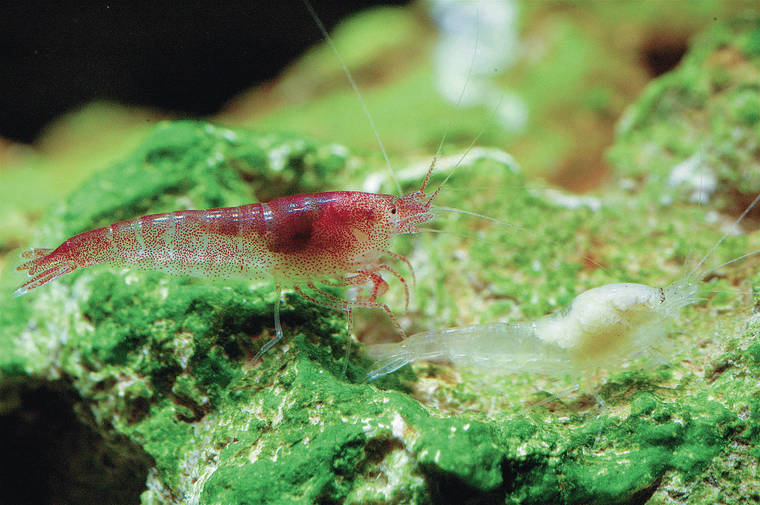If you dig it, they will come. Opae ula, that is.
When it comes to
Hawaii’s anchialine ponds, and the half-inch-long shrimp that colonize them, these words are no fantasy. When people, or nature, make holes in certain areas of Hawaii’s nearshore land, the little shrimp known in Hawaiian as opae ula appear.
Algae and bacteria grow in the new sunlit hole, the shrimp eat it and multiply. In good conditions, opae ula can live for 20 years.
The word “anchialine” comes from the Greek, “anchiolos,” meaning near the sea. A true anchialine pool can have no surface connection to the ocean, and must be deep enough to reach the water table, the level where the rocks and soil are permanently saturated with water.
Anchialine pool water
is usually a mixture of seawater and fresh water, both seeping through the cracks and fissures of lava fields. The salt concentration varies from pool to pool, but the hardy shrimp tolerate a wide range of salinity.
Opae ula have been found on all the main
Hawaiian Islands except Kauai. The shrimp have appeared in a bomb crater on Kahoolawe, in limestone sinkholes on Oahu’s Ewa plain and in natural and man-made holes on Hawaii island.
The Big Island has the most anchialine pools by far, hosting about 650 of the 700 or so found in
Hawaii.
When the circumstances of a hole or depression are right, Hawaii’s native opae ula appear like magic from their underground world of water-filled caverns. It doesn’t matter to the shrimp how the holes are made, or how barren or lush the surrounding surface is. Somehow the creatures survive for years in their black, subterranean fissures and then rise to the light when their world opens up.
Although eight species of shrimp inhabit Hawaii’s anchialine pools, the most common is Halocaridina rubra. This is the species sold as pets.
The words “ula” and “rubra” both mean red, but the shrimp come in red, pink, yellow, orange, clear and red-and-clear banded. Some of this color variation is genetic, and some is from diet, or even changes during courtship and mating. Most of
Oahu’s native opae ula are clear or pale pink.
The Big Island’s recent volcanic activity has opened up seven new pools and counting. All contain new colonies of
anchialine shrimp.
We can help protect these remarkable native animals by not swimming or snorkeling in their pools, never adding any kind of fish in the pools (fish eat them) and not dumping unwanted pet shrimp into a pool. Each
island has its own genetic variations, and you don’t know for sure where purchased shrimp came from.
I recently received a lovely gift of 15 or so clear-to-pink opae ula purchased on Oahu in 2016. My new pets are perfect office companions, hopefully inspiring me for years to keep marveling over, and writing about, Hawaii’s native species. And I didn’t even have to dig a hole.
To reach Susan Scott, go to susanscott.net Opens in a new tab and click on “Contact” at the top of her home page.

